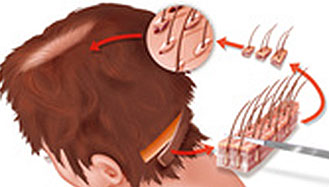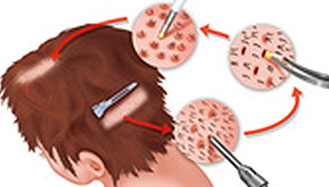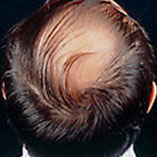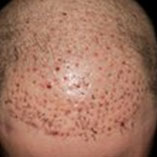Hair transplant surgery
About
Hair transplantation is a surgical method which relocates individual hair follicles from a part of the body referred to as the 'donor site ' to bald or balding part of the body known as the 'recipient site '. It is largely used to address male pattern hair loss. In this minimally invasive procedure, grafts holding hair follicles which are genetically resistant to balding are transferred to the hairless scalp.
It can also be employed to restore eyelashes, eyebrows, facial or corporal hair and to fill in scars induced by injuries or surgical procedure such as face-lifts and previous hair transplants.
Since hair normally grows in groups of 1 to 4 hairs, today's most advanced methods harvest and transplant these naturally occurring 1-- 4 hair "follicular units" in their natural groupings. Thus modern hair transplantation can accomplish a natural look by mirroring natural hair.
Procedure
Hair transplant surgeries normally last for 4-8 hours, are done under a mild (optional) sedation and with local anesthesia. Since there is no general anesthesia, there is no medical risk involved. The scalp is washed and then treated with an antibacterial agent; then the donor scalp is being harvested.
There are a number of various techniques available for the harvesting of hair follicles, but regardless of which donor harvesting technique is used, correct extraction of the hair follicle is critical to assure the viability of the transplanted hair and avoid the severing of the hair shaft from the hair follicle. Hair follicles grow at a slight angle to the skin's surface, which means that no matter of technique transplant tissue must be extracted with a matching angle and not perpendicular to the surface.
Post surgical antibiotics are often recommended to protect against damage or graft infections.
There are two main manners in which donor grafts are extracted today: strip harvesting and follicular unit extraction (FUE).

Strip harvesting
This hair transplant technique is called Follicular Unit Transplantation (FUT) and is currently used by the majority of hair transplant surgeons worldwide. The recipient area is measured so that the number of necessary hair folliculs is estimated. The hair density from the donor area is then counted using a densitometer, then the donor area is anesthetized with local anesthetic and the strip is marked and excised. The incision is then closed - resulting in a very small to almost invisible scar in majority of patients. Meanwhile the strip is dissect by assistants in individual follicular unit grafts (naturally occurring groups of 1-4 hairs), carefuly to minimize transection (the cutting of the foliculle).
The surgeon then uses a special tool to puncture the scalp from the recipient sites for receiving the grafts, in a carefully determined density, pattern and angle, so the final result to be realistic. The final part of the procedure is to insert the individual hair grafts in place,after eliminating the excess surrounding tissue.
Strip harvesting will leave a very fine scar in the donor area, easilly masked by the existing hair - or, if the suture technique is very meticulous (Trichophytic closure), the surgery may result in no scar at all. The medical personnel will instruct the pacient about what to do in the recovery period (see also our Hair transplant Patient's Guide).
Very important! You must be deemed appropriate for the surgery! Be careful to inform the physician about any alergies or medical problems you have!
Check The differences between FUE and strip technique
Check our Medical Database

Follicular unit extraction (FUE)
It is a more lenghty procedure and hair transplant sessions that use thousands of follicular unit grafts may take one or even two consecutive days. Also, not every patient can be a candidate for FUE and there are tests to determine that.
The donor area is shaved and local anesthetic is injected. Then individual follicular units containing 1 to 4 hairs are removed using an automated or manual punch machine, who create 0.6-1.00mm size punches based on individual hair character. This is carefully done with depth control to avoid graft transaction - but the transaction rate can be higher than in FUT. The grafts are then individually pulled out using special forceps and trimmed as needed under microscope. The grafts are graded and immersed in saline solution to prevent desication and are then ready for transplantation. The surgeon then uses a special tool to puncture the scalp from the recipient sites for receiving the grafts, in a carefully determined density, pattern and angle, so the final result to be realistic. The final part of the procedure is to insert the individual hair grafts in place.
There is no scar at the back of the skull and within a week the donor site hairs will grow and will cover most of the punched holes. The medical personnel will instruct the pacient about what to do in the recovery period (see also our Hair transplant Patient's Guide).
Very important! You must be deemed appropriate for the surgery! Be careful to inform the physician about any alergies or medical problems you have!
Check The differences between FUE and strip technique
Check our Medical Database
Combination strip and FUE
A combination of these two techniques can be performed when more grafts are needed and only one technique cannot provide enough unit grafts. Also, this combination helps with problems associated with either FUT or FUE: scaring or damage surrounding hair follicles. And, if the patient will need more hair transplants in the future, there will will be many undamaged hair follicles to harvest.
Ask more!
Ask a medical representative a question about hair transplant:
Latest news
-

Transplant procedures can be somewhat painful mainly due to local anesthesia using injections into the scalp. But new procedures do not involve needles
-

Hair transplantation can be performed at any age, technicaly, but probably in many cases doctors recommend patients to wait up to an age close to 30 years.
-

-

Depending on the method used for harvesting grafts, recovery time can vary from a few days (FUE method) to 1-2 weeks (FUT or STRIP method)
-

Very important rules for a healty transition after hair transplant surgery.
-

What technique? FUE or STRIP? Advantages and disadvantages of each.
Latest forum posts
-


In the forums section you can receive informed answers (including from a medical representative) about hairtransplant issues, products or services of interest to you. Just ask!

